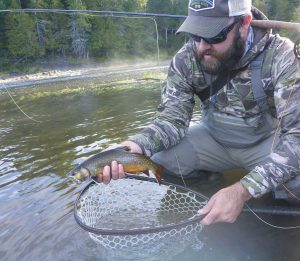Trouting the Beaverkill

By Dave Wilson
Along the far bank is a ledge of New York granite that runs the length of the pool. At first and last light the darkened granite looks like the silhouette of a prehistoric bear standing up to his belly in the stream, fishing. The branches of a Douglas fur hang over the bear’s massive shoulders and reach out over the head of the pool.
Upstream the leaves of dainty poplar and beach wave in the light over the riffle water on the long flat channel into the deep pool that begins under the bear’s snout.
On hot summer days, wading in jeans and felt soled wading shoes and keeping your casts quick and short and just beneath the overhang, you can take trout after trout in the slick nipple of water that peaks behind each rounded stone in the riffle water above the big fishing bear granite. Small grizzly hackle flies tied with a white deer hair tuft for visibility and buoyancy work best.
One sunny, breezy June day. you wade into center stream and settle yourself on a long, wide flat rock. Small trout sip gnats in the deep hole beneath the bear’s head. Excited you tie on a tiny black ant imitation and began to cast. On the third cast, the leader tippet, fine as a human hair does not turn over on your back cast and whistles past your ear in a terminal knotted mess.
You breathe deep and regather your line and yourself. Instead of using a store bought leader you decide to build a new one from scratch. You realize you’ve been sitting behind a desk too long. You focus only on tying the five blood knots one at a time to rebuild the nine foot leader: Three feet of twenty pound test to two of fifteen to a foot and a half of ten to a foot of five to a foot and a half of tippet as fine as a human hair.
You do not tie on a fly because the stream is always changing. You slow your heart to the beat of the river. You look around. You need to see a sign before you choose your fly this time. You know there are huge brown trout in this pool. They are very smart.
You find yourself in a zone of silence. You watch a mink scurry up his well worn path close to the rivers edge into the water, up his trail and vanish into the underbrush. A kingfisher drops from a spruce branch into the deep pool beneath the bear stone, plunges into the water neat as an Olympic diver and flaps up and back to his low branch, a black dace wriggling in his bill. You begin to hear your own heart beat it’s simple iambic pentameter into the orchestral moving waters of the Little Beaverkill.
The big fish begin to move in places you’d never expect. And there along the near shore a brown trout as long a your forearm turns out from under a long flat rock in the shallows, feeds, and slides back into his river stone from the opposite side of the stream from the deep hole under the bear head where the Kingfisher drops again, this time for a small trout.
And when at dusk the big drake mayflies begin to rise and the larger fish rise for them in the big pool under the lip of the long granite stone, you’ll need to still your heart again and slow your cast again, as you’ve learned to slow your golf swing to avoid a wild ball or in this case a wind knot, that you can ill afford when the big trout are on the rise on the Little Beaverkill…
.Dave Wilson lives in Key Largo and fishes Maine every chance he gets.
For more fishing articles, be sure to subscribe to our monthly outdoor magazine, The Northwoods Sporting Journal.
To access past copies of the Northwoods Sporting Journal in digital format at no charge, click here.
